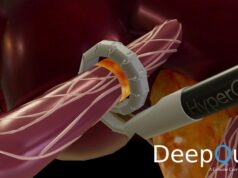
Ultrasound-based endovascular renal denervation can successfully reduce systolic blood pressure in patients with medication-resistant hypertension, as demonstrated by the results of a late-breaking clinical trial presented at the American College of Cardiology’s 70th Annual Scientific Session (ACC.21, 15–17 May, virtual).
Two-month findings from the RADIANCE-HTN TRIO trial—a multicentre, sham-controlled randomised single-blind study involving the Paradise Ultrasound Renal Denervation System (ReCor Medical)—were presented by interventional cardiologist Ajay J Kirtane (Columbia University, New York, USA). Regarding the trial’s primary efficacy endpoint, which was the change in daytime ambulatory systolic blood pressure, he reported an 8mm decrease of mercury in the trial’s renal denervation arm, compared to a 3mm drop in the sham procedure arm, resulting in a median difference of -4.5mmHg between the two groups.
“The greater blood pressure-lowering effect of renal denervation versus sham procedure was also consistent for 24-hour, nighttime, and office systolic blood pressure,” Kirtane said. “These results are concordant with those of the RADIANCE-HTN SOLO trial in patients with mild-to-moderate hypertension, which we published previously, confirming that ultrasound renal denervation can lower blood pressure across a spectrum of hypertension—but longer-term assessments for efficacy and safety are necessary, and ongoing.”
Endovascular renal denervation is used to reduce blood pressure in patients with mild-to-moderate hypertension—although its blood pressure-lowering effects have not been previously demonstrated “with confidence” in patients with resistant hypertension, according to Kirtane. The RADIANCE-HTN TRIO trial was therefore set up with the objective of investigating if endovascular ultrasound renal denervation reduces daytime ambulatory systolic blood pressure in patients with hypertension that is resistant to a standardised, fixed-dose, triple-medication pill.
The beginning of the study involved enrolling and screening 989 patients who had high blood pressure (≥140/90) despite being on three or more antihypertensive medications, and then putting all eligible participants on a fixed-dose, three-drug combination pill for four weeks in order to standardise therapy across the patient cohort. These patients had their blood pressure levels reassessed and underwent non-invasive screening at four weeks to ensure eligibility for renal denervation—a process that led to just 136 (13.7%) of the initially enrolled patients ultimately undergoing randomisation into either the renal denervation group (n=69), or the sham procedure group (n=67).
Kirtane explained, however, that this drop-off was due to the fact that the majority of patients’ blood pressure did decrease once they were put on a single, three-drug regimen for four weeks, to the point where they were no longer eligible to undergo renal denervation. “That is an important point, irrespective of where the role of denervation is in the future,” he added, in addition to reporting treatment adherence rates of 83% in the denervation group and 76% in the sham group at baseline, and 82% adherence in both groups at two months.
In addition to reporting a median difference in two-month daytime ambulatory systolic blood pressure of -4.5mmHg between the two groups, in the intent-to-treat population specifically, Kirtane also noted that six patients in the renal denervation arm did not have their ambulatory blood pressure measured at follow-up, and as such their blood pressure change was recorded as zero. Upon excluding these patients and restricting the analysis to patients for whom the researchers did have ambulatory blood pressure readings, however, the blood pressure change in the renal denervation group was -9.7mmHg, leading to an even more profound median difference between the groups of -5.8mmHg.
Reporting more granular data from the trial, Kirtane noted, in addition to daytime ambulatory systolic blood pressure decreasing with renal denervation, there was a differentially greater drop in nighttime ambulatory blood pressure between the two groups, and, as such, “overall 24-hour blood pressure dropped to an even greater extent with denervation compared to the sham procedure in the intent-to-treat population—and, in the complete cohort, these results were even further magnified”. When defining control of blood pressure as a daytime ambulatory blood pressure of <135/85mmHg, this was also observed to a “proportionally greater extent” with renal denervation (38%) compared to the sham group (21%), while changes in office and home systolic blood pressure readings at two months paralleled the study’s overall results as well.
In addition to concluding that the RADIANCE-HTN TRIO trial’s two-month findings confirm ultrasound-based renal denervation “can lower blood pressure across a spectrum of hypertension”, Kirtane stated that follow-up in this trial will also take place out to six and 12 months, as well as at two, three, four and five years in the future. He added that further follow-up will be required to assess whether the blood pressure-lowering effects of ultrasound renal denervation remain safe and durable over time, especially when patients who remain uncontrolled receive additional antihypertensive medications.
In a discussion following presentation of these findings, George Bakris (University of Chicago Medical Center, Chicago, USA) referred back to the positive results seen in the majority of patients who received a single, three-drug regimen for four weeks. “I want to congratulate you for using [combination therapy],” he said. “I cannot overemphasise to the audience—combo therapy as an initial therapy in these patients, it works!” On the topic of treatment adherence, Bakris added: “Normal adherence has been looked at—it is about 45%—and you doubled it with combination therapy. That is a paper in and of itself, by the way.” Kirtane followed this by stating that “adherence, and how we measure it, is problematic”, even within the confines of a clinical trial.
Bakris also quizzed Kirtane on whether the procedure indicated in the trial hits the branches of the renal artery, as well as the main vessel itself, as this is required to achieve “really good denervation” of at least 96%. Kirtane responded by stating that the specific procedure used in the RADIANCE-HTN TRIO trial affects a circumferential ablation at a depth of 1–6mm, without having to go distally into the arterial branches—also citing the results of the RADIOSOUND randomised trial published in Circulation that demonstrated the effectiveness of ultrasound renal denervation of the main arteries alone without having to go into the distal branches.








